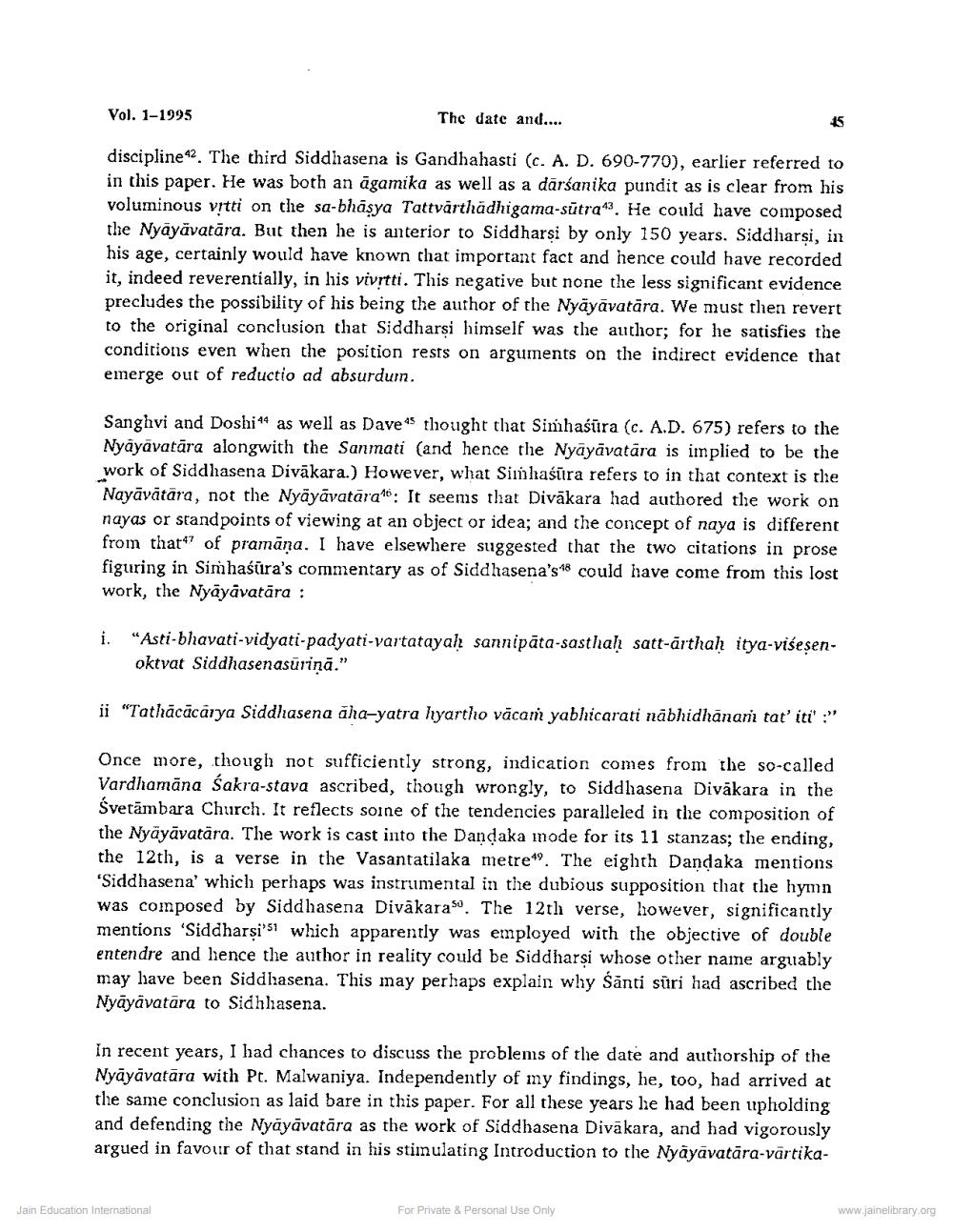Book Title: Date and Authorship of Nyayavatara Author(s): M A Dhaky Publisher: Z_Nirgrantha_1_022701.pdf and Nirgrantha_2_022702.pdf and Nirgrantha_3_022703.pdf View full book textPage 7
________________ Vol. 1-1995 The date and.... disciplines. The third Siddhasena is Gandhahasti (c. A. D. 690-770), earlier referred to in this paper. He was both an agamika as well as a darśanika pundit as is clear from his voluminous vitti on the sa-bhasya Tattvārthadhigama-sūtra43. He could have composed the Nyāyāvatāra. But then he is anterior to Siddharsi by only 150 years. Siddharsi, in his age, certainly would have known that important fact and hence could have recorded it, indeed reverentially, in his vivítti. This negative but none the less significant evidence precludes the possibility of his being the author of the Nyāyāvatāra. We must then revert to the original conclusion that Siddharsi himself was the author; for he satisfies the conditions even when the position rests on arguments on the indirect evidence that emerge out of reductio ad absurdum. Sanghvi and Doshi 44 as well as Dave's thought that Simhaśūra (c. A.D. 675) refers to the Nyāyāvatāra alongwith the Sanmati (and hence the Nyayāvatāra is implied to be the work of Siddhasena Divakara.) However, what Simhaśūra refers to in that context is the Nayāvātāra, not the Nyāyāvatāras. It seems that Divākara had authored the work on nayas or standpoints of viewing at an object or idea; and the concept of naya is different from that47 of pramāna. I have elsewhere suggested that the two citations in prose figuring in Simhaśūra's commentary as of Siddhasena's *8 could have come from this lost work, the Nyāyāvatāra : i. "Asti-bhavati-vidyati-padyati-vartatayah sannipāta sasthah satt-ārthah itya-višesen oktvat Siddhasenasūriņā." ii "Tathācācārya Siddhasena āha-yatra hyartho vācam yabhicarati nābhidhānan tat' iti'." Once more, though not sufficiently strong, indication comes from the so-called Vardhamana sakra-stava ascribed, though wrongly, to Siddhasena Divākara in the Svetāmbara Church. It reflects soine of the tendencies paralleled in the composition of the Nyāyāvatāra. The work is cast into the Dandaka mode for its 11 stanzas; the ending, the 12th, is a verse in the Vasantatilaka metre"). The eighth Dandaka mentions 'Siddhasena' which perhaps was instrumental in the dubious supposition that the hymn was composed by Siddhasena Divakaras. The 12th verse, however, significantly mentions 'Siddharşist which apparently was employed with the objective of double entendre and lience the author in reality could be Siddharsi whose other name arguably may have been Siddhasena. This may perhaps explain why Šānti sūri had ascribed the Nyāyāvatāra to Sidhlasena. in recent years, I had chances to discuss the problems of the date and authorship of the Nyāyāvatāra with Pt. Malwaniya. Independently of my findings, he, too, had arrived at the same conclusion as laid bare in this paper. For all these years he had been upholding and defending the Nyāyāvatāra as the work of Siddhasena Divākara, and had vigorously argued in favour of that stand in his stimulating Introduction to the Nyāyāvatāra-vārtika Jain Education International For Private & Personal Use Only www.jainelibrary.orgPage Navigation
1 ... 5 6 7 8 9 10 11
